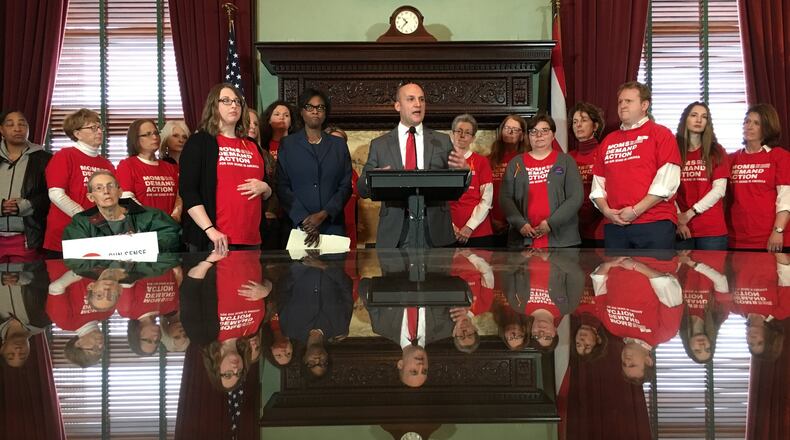On Wednesday, state Sens. Joe Schiavoni, D-Boardman, and Sandra Williams, D-Cleveland, introduced a Red Flag bill in the Ohio Senate to allow family or law enforcement to petition a court to order confiscation of firearms from people who appear to be a risk to themselves or others.
“This legislation can help save lives by creating a clear process for action before warning signs escalate into tragedy — and we know there are warning signs,” Williams said at a press conference Wednesday with Moms Demand Action, a national gun control group. She noted that in half of mass shootings from 2009 to 2016, 42 percent of the attackers exhibited warning signs before the shootings.
Related: On gun issues, Ohio’s governor candidates far apart
Related: Kasich proposes major changes to Ohio gun laws
The bill is likely to run into opposition from gun rights advocates in Ohio.
“Taking someone’s property without due process is wrong. It’s completely un-American,” said Jim Irvine, board president of the Buckeye Firearms Association. He added, “Gun control is a failed idea. Continuing to push it is refusing to accept reality.”
Indiana Attorney General Curtis T. Hill, Jr., a Republican, backs the law in his state and says it could be a national model.
“I hope Ohioans take the lead of Indiana and enact this type of law,” he said. After the Florida shooting, Hill’s office issued an advisory to Indiana police and prosecutors about how to make effective use of the red flag law.
Indiana passed its Red Flag Law in 2005, shortly after Indianapolis Police Patrolman Jake Laird was shot and killed by a rifle-toting man, who suffered from mental illness and had previously been violent and unstable.
The law authorizes police to confiscate weapons from people deemed dangerous — if they present an imminent risk to themselves or others or a potential risk and have either been diagnosed with a mental illness and failed to take prescribed medications or there is documentation of a propensity for violent, unstable conduct. It is used to remove guns where suicide or domestic violence is a possibility.
Hill said “There is a wide array of applicability for the law. Everyone is focused now on school shootings but it’s not just for school safety issues.”
According to the National Conference of State Legislatures, at least 25 states are considering Red Flag legislation, also known as Extreme Risk Protective Orders or Gun Violence Prevention Orders. California, Connecticut, Oregon, Washington, Indiana, Florida and Rhode Island already have such laws on the books.
The Educational Fund to Stop Gun Violence research shows in the first 14 years of Connecticut’s law, 762 risk warrants were issued and police found firearms in 99 percent of the cases, removing on average seven guns per person. Suicide or self-injury was listed as a concern in 61 percent of those cases.
“Research estimates for every 10 to 20 risk warrants issued, one life is saved,” the group said.
Ohio Gov. John Kasich proposed six gun reforms, including a red flag law, to help prevent gun violence, such as school shootings. But such a law may also help prevent suicides: 924 Ohioans died by suicide using firearms in 2016.
Irvine, though, pushed back, noting that when actor Robin Williams used a belt to hang himself, no one said there is a ‘belt-violence’ problem in the United States. “Banning the guns will not solve the suicide problem,” Irvine said.
Related: 21 gun bills pending in Ohio. What would they do?
Related: Ohio firearms group says gun owners are ‘doing something’
Meanwhile, state Rep. Thomas West, D-Canton, recently introduced two bills that likely would increase the time it takes to purchase a firearm. House Bill 563 would bar federally licensed firearms dealers from transferring a gun to a buyer while a background check is pending, unless 30 days have elapsed. House Bill 564 would mandate a 72-hour waiting period between purchase and delivery of a firearm. He is also sponsoring a bill to raise the purchase age for semi-automatic weapons to 21 or older.
About the Author

